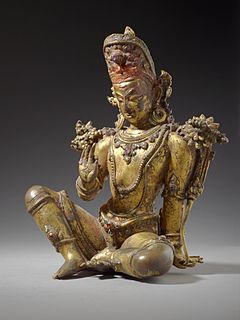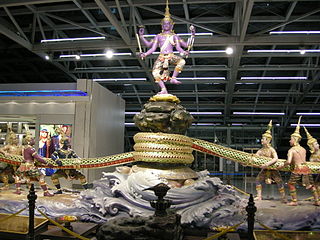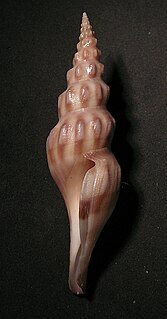
Asuras are a class of beings or power-seeking clans related to the more benevolent Devas in Hinduism.
Hindu deities are the gods and goddesses in Hinduism. The terms and epithets for deity within the diverse traditions of Hinduism vary, and include Deva, Devi, Ishvara, Ishvari, Bhagavān and Bhagavati.

Kurma, also known as 'KurmaRaja' is an avatar of the Hindu god Vishnu. Originating in Vedic literature such as the YajurVeda as being synonymous with the Saptarishi called Kasyapa, Kurma is most commonly associated in post-Vedic literature such as the Puranas with the legend of the churning of the Ocean of Milk, referred to as the Samudra manthan. Also synonymous with Akupara, the world-turtle supporting the Earth, Kurma is listed as the second incarnation of the Dashavatara, the ten principal avatars of Vishnu.

The Luzon bleeding-heart is one of a number of species of ground dove in the genus Gallicolumba that are called "bleeding-hearts". The Luzon Bleeding-heart is the species in which the "blood" feature is most pronounced, with the reddish hue extending down the belly, furthering the illusion of blood having run down the bird's breast.

Deva means "heavenly, divine, anything of excellence", and is also one of the terms for a deity in Hinduism. Deva is a masculine term; the feminine equivalent is Devi.

Mahishasura was a buffalo Asura in Hinduism. He is known among Hindus of most sects as a deceitful demon who pursued his evil ways by shape-shifting. Mahishasura was the son of Rambha, and the great-grandson of Brahmarshi Kashyapa. He was ultimately killed by Goddess Durga - after which She gained the epithet Mahishasuramardini. The Navaratri festival eulogizes this battle between Mahishasura and Durga, culminating in Vijaya Dasami, a celebration of his ultimate defeat. This story of the "triumph of Good over Evil" carries profound symbolism in Hinduism, particularly Shaktism, and is both narrated as well as reenacted from the Devi Mahatmya at many South- and Southeast Asian Hindu temples. The story is also told in the Sikh text Chandi di Var, also called Var Durga Di, which many in Sikh tradition believe was included in the Dasam Granth by Guru Gobind Singh.

The Philippine duck is a large dabbling duck of the genus Anas. Its native name is papan. It is endemic to the Philippines. As few as 5,000 may remain. Overhunting and habitat loss have contributed to its decline.

A daeva is a Zoroastrian supernatural entity with disagreeable characteristics. In the Gathas, the oldest texts of the Zoroastrian canon, the daevas are "gods that are rejected". This meaning is – subject to interpretation – perhaps also evident in the Old Persian "daiva inscription" of the 5th century BCE. In the Younger Avesta, the daevas are divinities that promote chaos and disorder. In later tradition and folklore, the dēws are personifications of every imaginable evil.
Balakata is a genus of trees in the family Euphorbiaceae first described as a genus in 1999. It is native to Southeast Asia, southern China, the Himalayas, and New Guinea. The genus name was inspired by balákat-gúbat ("shoulder-tree"), the Philippine common name for B. luzonica.

The Samudra Manthana is one of the best-known episodes in the Hindu philosophy narrated in the Bhagavata Purana, in the Mahabharata and in the Vishnu Purana. The Samudra Manthana explains the origin of Amrita, the nectar of immortality and the omnipotent god of destruction Shiva drank the vish.

An asura in Buddhism is a demigod or titan of the Kāmadhātu. They are described as having three heads with three faces each and either four or six arms.
The Kālakeyas or Kālakhañjas are a class of Asura in Hindu mythology. They were a powerful, ferocious and cruel clan of the Dānavas.

Asura is a genus of moths in the subfamily Arctiinae erected by Francis Walker in 1854.

Comitas is a genus of medium-sized sea snails, marine gastropod molluscs in the family Pseudomelatomidae.

Lyclene is a genus of lichen moths of the family Erebidae, subfamily Arctiinae. The genus was erected by Frederic Moore in 1860.
Ethulia is a genus of Asian and African flowering plants in the daisy family.

Asura's Wrath is an action video game developed by CyberConnect2 and published by Capcom. Asura's Wrath was first announced at the Tokyo Game Show in 2010, and was released worldwide in February 2012. The game is playable on PlayStation 3, Xbox 360, Xbox One via 360 backwards compatibility, and the PlayStation 4 and PC via PlayStation Now.

Cyme sexualis is a moth of the subfamily Arctiinae first described by Felder in 1864. It is found on Ambon, Sulawesi, the Dampier Archipelago. and in New Guinea.
Scaptesyle luzonica is a moth in the subfamily Arctiinae. It is found in the Philippines (Luzon).

Gnoma luzonica is a species of beetle in the family Cerambycidae. It was described by Wilhelm Ferdinand Erichson in 1834, originally as G. luzonicum. It is known from the Philippines.













